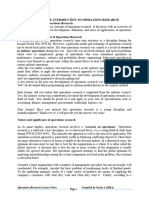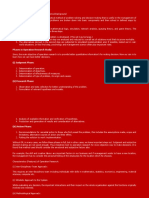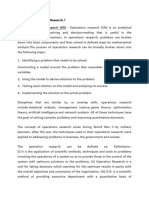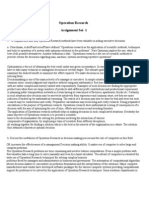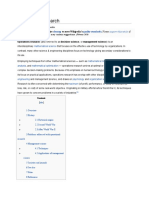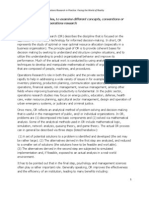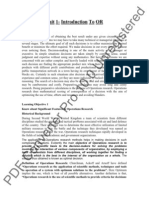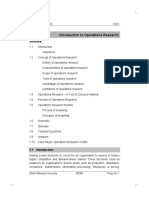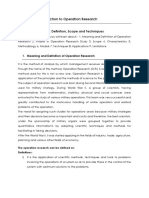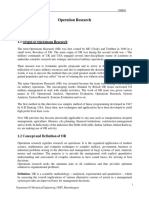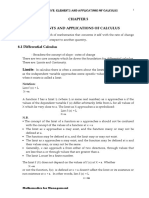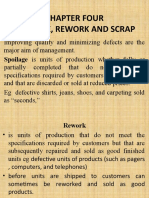New Ch1 OR
New Ch1 OR
Uploaded by
Wudneh Amare0 ratings0% found this document useful (0 votes)
23 views15 pagesOperations research is a scientific approach that uses quantitative methods to help managers make better decisions. It developed during World War II to help manage scarce resources for military operations more effectively. Operations research involves constructing mathematical models of problems to analyze relationships between variables and evaluate alternative solutions. The goal is to find the optimal solution that benefits the entire organization, not just individual departments. Key aspects of the operations research approach include using interdisciplinary teams, scientific methods, a holistic view of the entire system, and defining objective measures of desirability to compare alternatives.
Original Description:
Copyright
© © All Rights Reserved
Available Formats
DOCX, PDF, TXT or read online from Scribd
Share this document
Did you find this document useful?
Is this content inappropriate?
Report this DocumentOperations research is a scientific approach that uses quantitative methods to help managers make better decisions. It developed during World War II to help manage scarce resources for military operations more effectively. Operations research involves constructing mathematical models of problems to analyze relationships between variables and evaluate alternative solutions. The goal is to find the optimal solution that benefits the entire organization, not just individual departments. Key aspects of the operations research approach include using interdisciplinary teams, scientific methods, a holistic view of the entire system, and defining objective measures of desirability to compare alternatives.
Copyright:
© All Rights Reserved
Available Formats
Download as DOCX, PDF, TXT or read online from Scribd
Download as docx, pdf, or txt
0 ratings0% found this document useful (0 votes)
23 views15 pagesNew Ch1 OR
New Ch1 OR
Uploaded by
Wudneh AmareOperations research is a scientific approach that uses quantitative methods to help managers make better decisions. It developed during World War II to help manage scarce resources for military operations more effectively. Operations research involves constructing mathematical models of problems to analyze relationships between variables and evaluate alternative solutions. The goal is to find the optimal solution that benefits the entire organization, not just individual departments. Key aspects of the operations research approach include using interdisciplinary teams, scientific methods, a holistic view of the entire system, and defining objective measures of desirability to compare alternatives.
Copyright:
© All Rights Reserved
Available Formats
Download as DOCX, PDF, TXT or read online from Scribd
Download as docx, pdf, or txt
You are on page 1of 15
CHAPTER ONE
INTRODUCTION TO OPERATIONS RESEARCH
1.1 Operations Research-A Quantitative Approach to Decision- Making
Operations Research (also referred to Management Science, quantitative methods,
quantitative analysis, and decision sciences) is the application of a scientific approach to solve
management problems in order to help managers to make better decisions. As implied by this
definition, management science encompasses a number of mathematically oriented techniques
that have been developed within the field of management science or been adapted from other
disciplines such as the natural sciences, mathematics, statistics, and engineering. Management
science, although rather young, is recognized and established discipline in the field of business
administration.
Operations Research, as one of the quantitative aid to decision-making offers the decision-maker
a method of evaluating every possible alternative (act or course of action) by using various
techniques to know the potential outcomes. In general, while solving a real-life problem, the
decision-maker must examine it both from quantitative as well as qualitative perspective.
Information about the problem from both these perspectives needs to be brought together and
assessed in the context of the problem.
1.2 The history of operations research
It is generally agreed that operations research came into existence as a discipline during World
War II when there was a critical need to manage scarce resources. However, a particular model
and technique of OR can be traced back to much earlier times. The term ‘operations research’
was confined as a result of research on military operations during this war. Since the war
involved strategic and tactical problems which were greatly complicated, to expect adequate
solutions from individuals or specialists in a single discipline was unrealistic. Therefore, groups
of individual who collectively were considered specialists in mathematics, economics, statistics
and probability theory, engineering, behavioral, and physical science were formed as special
units within the armed forces to deal with strategic and tactical problems of various military
operations.
1.3 Nature and significance of operations research\
As the term implies, OR involves research on military operations. This indicates the approach as
well as the area of its applications. The operations research approach is particularly useful in
balancing conflicting objectives (goals or interests) where there are many alternative courses of
Amu, Departement of Management Page | 1
action available to the decisions–makers. In theoretical sense, the optimum decision must be one
that is best for the organization as a whole. It is often called the global optimum. A decision that
is best for one or more sections of the organization is usually called suboptimum decision. The
OR approach attempts to find global optimum by analyzing inter-relationships among the system
components involved in the problem (described below).
Consider a large organization with a number of management specialists but not necessarily well
coordinated. For example, consider the basic problem of maintaining stocks of finished goods.
To the marketing manager, stocks of a large variety of products are a means of supplying the
company’s customers with what they want and when they want it. Clearly, according to a
marketing manager, a fully stocked warehouse is of prime importance to the company. But the
production manager argues for long production runs preferably on a smaller product range,
particularly if significant time is lost when production is switched from one variety to another.
The result would again be a tendency to increase the amount of stock carried but it is, of course,
vital that the plant should be kept running.
On the other hand, the finance manager sees stocks in terms of capital tied up unproductively and
argues strongly for their reduction. Finally, there appears the personnel manager for whom a
steady level of production so advantageous for having better labour relations. Thus, all these
people would claim to uphold the interests of the organization, but they do so only from their
specialized points of view. They may come up with contradictory solutions and obviously, they
cannot all be right.
In view of the above involving the whole system, the decision-maker, whatever his
specialization, will need help and it is in the attempt to provide this assistance that OR has been
developed. Operations research attempts to resolve the conflicts of interest among various
sections of the organization and seeks the optimal solution which may not be acceptable to one
department but is in the interest of the organization as a whole. Further, OR is concerned with
providing the decision-maker with decision aids (or rules) derived from:
(i) A total system orientation,
(ii) Scientific methods of investigation, and
(iii) Models of reality, generally based on quantitative measurement and techniques.
Thus, successful application of OR techniques for solving a problem must involve the following
steps.
1. Constructing mathematical, economic or statistical model of the problem under study to treat
situations of complexity and uncertainty. This helps to view the problem in its entirety.
Amu, Departement of Management Page | 2
2. Analyzing the relationships among different variables and/or parameters associated with the
problem, so as to determine consequences of decision alternatives.
3. Suggesting suitable measure of desirability (effectiveness or objective function) in order to
evaluate the relative merit of decision alternatives (courses of action, acts or strategies).
Remark: A system is defined as an arrangement of components designed to achieve a particular
objective or objectives according to plan. The components may be either physical or conceptual
or both but they share a unique relationship with each other and with the overlay objective of the
system.
1.4 FEATURES OF OPERATIONS RESEARCH APPROACH
The features of OR approach to any decision and control problem can be summarized as under.
1.4.1. Interdisciplinary Approach
Interdisciplinary teamwork is essential because while attempting to solve a complex
management problem, one person may not have the complete knowledge of all its aspects (such
as economic, social, political, psychological, engineering, etc.). This means we should not expect
a desirable solution to managerial problems. Therefore, team of individuals specialized in
mathematics, statistics, economics, engineering, computer science, psychology, etc., can be
organized so that each aspect of the problem could be analyzed by a particular specialist in that
field in order to arrive at an appropriate and desirable solution of the problem. However, there
are certain problem situations which may be analyzed even by one individual.
1.4.2. Methodological Approach
Operations research is the application of scientific methods, techniques and tools to problems
involving the operations of systems so as to provide those in control of operations with optimum
solutions to the problems. The scientific method consists of observing and defining the problem;
formulating and testing their hypothesis; and analyzing the results of the test. The data so
obtained is then used to decide whether the hypothesis should be accepted or not. If the
hypothesis is accepted, the results should be implemented otherwise an alternative hypothesis
has to be formulated.
1.4.3. Holistic Approach: While arriving at a decision, an operations research team examines the
relative importance of all conflicting and multiple objectives and the validity of claims of various
departments of the organization from the perspective of the whole organization.
1.4.4. Objectivistic Approach
An operations research approach seeks to obtain an optimal solution to the problem under
analysis. For this, a measure of desirability (or effectiveness) is defined, based on the objective
Amu, Departement of Management Page | 3
(s) of the organization. A measure of desirability so defined is then used to compare alternative
courses of action with respect to their outcomes.
1.5. Operations research: some definitions
Because of the wide scope of application of operations research giving a precise definition is
difficult. However, a few definitions of OR are given below:
Operations research is the application of the methods of science to complex problems in the
direction and management of large systems of men, machines, materials and money in
industry, business, government and defiance. The distinctive approach is to develop a scientific
model of the system incorporating measurements of factors such as chance and risk, with
which to predict and compare the outcomes of alternative decisions, strategies or controls. The
purpose is to help management in determining its policy and actions scientifically (Operational
Research Society, UK).
Operations research is concerned with scientifically deciding how to best design and operate
man-machine systems usually requiring the allocation of scarce resources. Operations Research
society, America A part from being lengthy, the definition given by Operational Research
Society of UK, has been criticized because it emphasized complex problems and large systems,
leaving the reader with the impression that it is a highly technical approach suitable only to
large organizations. The keywords used in the above definitions are scientific approach, scarce
resources, system and model.
One of the best definitions is as follows.
Operations research, in the most general sense, can be characterized as the application of
scientific methods, techniques and tools, to problems involving the operations of a system so
as to provide those in control of the operations with optimum solutions to the problems
(Curchman, Ackoff and Arnoff, 1957).
Operations research is the art of winning wars without actually fighting them (Auther Clark).
This definition refers to the military origin of the subject where team of experts were "not
actually participating' in military (operations for winning the war but providing advisory and
intellectual support for imitating strategic military actions.
Operations research is the art of finding bad answers to problems to which otherwise worse
answers are given. This definition refers operations research as a technique for selecting the
best course of action out of several courses of action to reach a desirable solution of the
problem.
Amu, Departement of Management Page | 4
A few of definitions of OR are as follows:
Operations research has been described as a method, an approach, a set of techniques, a team
activity, a combination of many disciplines, an extension of particular disciplines
(mathematics, engineering, and economics).
Operations research may be described as a scientific approach to decision-making that
involves the operations of organizational system (F. S. Hiller and G J Lieberman, 1980).
Operations research is a scientific method of providing executive departments with a
quantitative basis for decisions under their control (P. M. More and G E Kimball).
Operations research is applied decision theory. It uses scientific, mathematical, or logical
means to attempt to cope with the problems that confront the executive, when he tries to
achieve a through-going rationality in dealing with his decision problems (D. W. Miller and
M K Stan).
Operations research is a scientific approach to problem-solving for executive management (H.
M Wagner).
1.6 APPLICATIONS OF OPERATIONS RESEARCH
Operation Research is mainly concerned with the techniques of applying scientific knowledge,
besides the development of science. Some applications of O.R. in the functional areas of
management are briefly presented here under.
1. Finance, Budgeting, and Investment
i. Cash flow analysis, long range capital requirements, dividend policies, investment portfolios.
ii. Credit policies, credit risks and adequate account procedures.
iii. Claim and complaint procedure.
2. Marketing
i) Product selection, timing, comparative actions.
ii) Advertising media with respect to cost and time.
iii) Number of salesmen, frequency of calling of account, etc.
iv) Effectiveness of market research.
3. Physical Distribution
i) Location and size of warehouses, distribution centers, retail outlets, etc.
ii) Distribution policy.
4. Purchasing, Procurement and Exploration
i) Rules of buying.
Amu, Departement of Management Page | 5
ii) Determine the quality and timing of purchase.
iii) Bidding policies and vendor analysis.
iv) Equipment replacement policies.
5. Personnel
i) Forecasting the manpower requirement, recruitment policies and job assignments.
ii) Selection of suitable personnel with due consideration for age and skills, etc.
iii) Determination of optimum number of persons for each service center.
6. Production
i) Scheduling and sequencing the production run by proper allocation of machines.
ii) Calculating the optimum product mix.
iii) Selection, location and design of sites for the production plant.
7. Research and Development
i) Reliability and evaluation of alternative designs.
ii) Control of developed projects.
iii) Co-ordination of multiple research projects.
iv) Determination of time and cost requirements.
Besides the above-mentioned applications of O.R. in the context of modern management, its use
has now extended to a wide range of problems, such as the problems of communication and
information, socio-economic fields and national planning.
1.7 Models and modeling in operations research
A model: a model is an abstraction of reality. It is a simplified and often an idealized
representation of reality. By its very nature a model is incomplete. A good model captures the
important details of reality without including innumerable minor details. Both simple and
complex systems can easily be studied by concentrating on some portion or key features instead
of concentrating on every detail of it. This approximation or abstraction, maintaining only the
essential elements of the system, which may be constructed in various forms by establishing
relationships among specified variables and parameters of the system, is called a model.
In general, models attempt to describe the essence of a situation or activity by abstracting from
reality so the decision-maker can study the relationship among relevant variables in isolation.
Models do not attempt to duplicate reality in all aspects, but for models that do reveal nothing. In
other words, for a model to be effective, it must be representative of those aspects of reality that
are being investigated and have a major impact on the decision situation.
Amu, Departement of Management Page | 6
The key to model-building lies in abstracting only the relevant variables that affect the criteria of
the measures-of-performance of the given system and expressing the relationship in a suitable
form. There are many ways to classify models. Classification schemes can also provide a useful
frame of reference for modelers. There are eight classification schemes for models as shown
1.6.1 Classification Based on Structure
A. Physical Models
These models provide a physical appearance of the real object under study either reduced
in size or scaled up. Physical models are useful only in design problems because they are
easy to observe, build and describe. For example, in the aircraft industry, scale models of
the proposed new aircraft are built and tested in wind tunnels to record the stresses experienced
by the air frame. Since these models cannot be manipulated and are not very
useful for predication, problems such as portfolio selection, media selection, production
scheduling, etc., cannot be analyzed with a physical model. Physical models are classified into
the following two categories.
(I) Iconic Models. Iconic models retain some of the physical properties and characteristics
of the system they represent. An iconic model is either in an idealized form or is a scaled
version of the system. In other words, such models represent the system as it is by scaling
it up or down (i.e. enlarging or reducing the size). Examples of iconic models are blueprints of a
home, maps, globes, photographs, drawings, air place, trains, etc.
Iconic models are simple to conceive, specific, concrete and used to describe the characteristics
of the system rather than being explanatory. This means that such models are used to represent a
static even and characteristics which are not used in determining or predicting effects due to
certain changes in the actual system. For example, color of an atom does not play any vital role
in the scientific study of its structure. Similarly, type of engine in a car has no role to play in the
study of parking problem.
(ii) Analogue Models. These models represent a system by a set of properties different from
those of the original system and do not resemble it physically. After the problem is solved, the
solution is re-interpreted in terms of the original system. For example, the organizational chart
represents the state of formal relationships existing between members of the organization. Maps
in different colors may represent water, desert and other geographical features. Graphs of time
series, stock-market changes, frequency curves, etc., may be used to represent qualitative
relationships between any two properties and predict how a change in one property affects the
Amu, Departement of Management Page | 7
other. These models are less specific and concrete but are easier to manipulate and are more
general than iconic models.
(iii) Symbolic models. These models use symbols (letters, numbers) and functions to represent
variables and their relationships to describe the properties of the system. These models are also
used to represent relationships which can be represented in a physical form. Symbolic models
can be classified into two categories.
A. Verbal Models: These models describe a situation in written or spoken language. Written
sentences, books, etc., are examples of a verbal model.
B. Mathematical Models: These models involve the use of mathematical symbols, letters,
numbers and mathematical operators (+, -, ÷, x) to represent relationships among various
variables of the system to describe its properties or behavior. The solution to such models is then
obtained by applying suitable mathematical technique. The relationship among velocity, distance
and accelerations is an example of a mathematical model.
In accountings, the cost-volume-profit model is also an example of a mathematical model.
Symbolic models are precise and abstract and can be analyzed and manipulated by using laws of
mathematics. The models are more explanatory rather than descriptive.
1.6.2. Classification Based on Function or Purpose
Models based on the purpose of their utility include the following types.
Descriptive models
Descriptive models simply describe some aspects of a situation, based on observation, survey,
questionnaire results or other available data of a situation and do not predict or recommend
anything. Examples of such models are: Organization chart, plant layout diagram, block
diagram representing an algorithm or method for solving a problem, etc.
Predictive models
These models indicate ‘if this occurs, then that will follow’. They relate dependent and
independent variables and permit trying out, ‘what if’ questions. In other words, these models
are used to predict the outcomes due to a given set of alternatives for the problem. These
models do not have an objective function as a part of the model to evaluate decision
alternatives.
For example, S = a + bA + cI is a model that describes how the sale (S) of a product changes
with a change in advertising expenditure (A) and disposable personal income (I). Here a, b and
c are parameters whose values must be estimated. Thus, having estimated the values of a, b and
Amu, Departement of Management Page | 8
C, the value of advertising expenditure (A) can be adjusted for a given value of I to study the
impact of advertising on sales. In these models, however, one does not attempt to choose the
best decision alternative, but can only have an idea about each alternative available to him.
Normative (or Optimization) models
These models provide the ‘best’ or ‘optimal’ solution to problems subject to certain limitations
on the use of resources. These models provide recommended courses of action. For example, in
mathematical programming, models are formulated for optimizing the given objective
function, subject to restrictions on resources in the context of the problem under consideration
and non-negativity of variables. These models are also called prescriptive models because they
prescribe what the decision-maker ought to do.
1.6.3 Classification Based on Time Reference
Static models
Static models represent a system at some specified time and do not account for changes over
time. For example, an inventory model can be developed and solved to determine an economic
order quantity for the next period assuming that the demand in planning period would remain
the same as that for today.
Dynamic models
In a dynamic model, time is considered as one of the variables and allows the impact of
changes due to change in time. Thus, a sequence of interrelated decisions over a period of time
is made to select the optimal course of action to optimize the given objective. Dynamic
programming is an example of a dynamic model.
1.6.4. Classification Based on Degree of Certainty
Deterministic models
If all the parameters, constants and functional relationships are assumed to be known with
certainty when the decision is made, the model is said to be deterministic. Thus, in such a case,
the outcome associated with a particular course of action is known. That is, for a specific set of
input values, there is a uniquely determined output which represents the solution of the model
under conditions of certainty. The results of the models assume single value. Linear
programming models are examples of deterministic models.
Probabilistic (Stochastic) models.
Models in which at least one parameter or decision variable is random variable are called
probabilistic (or stochastic) models. Since at least one decision variable is random, therefore,
Amu, Departement of Management Page | 9
an independent variable which is the function of dependent variable (s) will also be random.
This means consequences or payoff due to certain changes in the independent variable cannot
be predicted with certainty. However, it is possible to predict a pattern of values of both the
variables by their probability distribution. Insurance against risk of fire, accidents, sickness,
etc. are examples where the pattern of events is studied in the form of a probability
distribution.
1.6.5. Classification Based on Method of Solution or Quantification
Heuristic models
These models employ some sets of rules which, though perhaps not optimal, do facilitate
solutions of problems when applied in a consistent manner.
Analytical models
These models have a specific mathematical structure and thus can be solved by known
analytical or mathematical techniques. Any optimization model (which requires maximization
or minimization of an objective function) is an analytical model.
Simulation models
These models also have a mathematical structure but are not solved by applying mathematical
techniques to get a solution. Instead, a simulation model is essentially a computer-assisted
experimentation on a mathematical structure of a real-life problem in order to describe and
evaluate its behaviors under certain assumptions over a period of time. Simulation models are
more flexible than mathematical ones and therefore, can be used to represent a complex system
which otherwise cannot be represented mathematically. These models do not provide general
solution like those of mathematical models.
1.7. Advantage of model
Models in general are used as an aid for analyzing complex problems. However, a model can
also serve other purposes as given below:
1. A model provides economy in representation of the realities of the system. That is, models
help the decision-maker to visualize a system so that he can understand the system’s structure
or operation in a better way. For example, it is easier to represent a factory layout on paper
than to construct it. It is cheaper to try out modifications of such systems by rearrangement
on paper.
2. The problem can be viewed in its entirety, with all the components being considered
simultaneously.
Amu, Departement of Management Page | 10
3. Models serve as aids to transmit ideas and visualization among people in the organization.
For example, a process chart can help the management to communicate about better work
methods to worker.
4. A model allows us to analyze and experiment in a complex situation to a degree that would
be impossible in the actual system and its environment. For example, the experimental firing
of INSAT satellite may cost millions of dollars and require years of preparation.
5. Models simplify the investigation considerably and provide a powerful and flexible tool for
predicting the future state of the process or system.
1.8. METHODELOGY OF OPERATION RESEARCH
Every OR specialist may have his/her own way of solving problems. However, for effective
use of OR techniques, it is essential to follow some steps that are helpful for decision-makers
to make better decisions.
Step 1: Formulating the Problem
Problem formulation involves an analysis of the system under study, the objective of the
decision-maker, and alternative courses of action, etc., so as to understand and describe, in
precise terms, the problem that an organization faces. The analysis begins by detailed
observation of the organizational structure, climate, communication and control system, its
objectives and expectations. Such information will help in assessing the difficulty of the
study in terms of costs, time requirement, resource requirement, probability of success of the
study, etc. The major steps which have to be taken into consideration for formulating the
problems are as follows:
Step 2: Collecting Data and Constructing a Mathematical Model
After the problem is clearly defined and understood, the next step is to collect required data
and then formulate a mathematical model. Model construction consists of hypothesizing
relationships between variables subject to and not subject to control by decision-maker.
Step 3: Solving the Mathematical Model
Once a mathematical model of the problem has been formulated, the next step is to solve it,
that is, to obtain numerical values of decision variables. Obtaining these values depends on
the specific form or type, of mathematical model. Solving the model requires the use of
various mathematical tools and numerical procedures. In general, the following two
categories of methods are used for solving an OR model.
Amu, Departement of Management Page | 11
(i) Optimization Methods: These methods yield the best values for the decision variables
both for unconstrained and constrained problems. In constrained problems, these values
simultaneously satisfy all the constraints and provide an optimal or acceptable value for the
objective function or measure of effectiveness. The solution so obtained is called the optimal
solution to the problem.
(ii) Heuristic Methods: These methods yield values of the variables that satisfy all the
constraints, but not necessarily provide optimal solution. However, these values provide an
acceptable value for the objective function.
Heuristic methods are sometimes described as rules of thumb which work. An example of a
commonly used heuristic is ‘stand in the shortest line’. Although using this rule may not
work if everyone in the shortest line requires extra time, in general, it is not a bad rule to
follow. These methods are used when obtaining optimal solution is either varies time
consuming or model is complex.
Steps 5: Implementing the Solution
The decision-maker has not only to identify good decision alternatives but also to select
alternatives that are capable of being implemented. It is important to ensure that any solution
implemented is continuously reviewed and undated in the light of a changing environment.
The behavioral aspects of change are exceedingly important to the successful implementation
of results. In any case, the decision-maker who is in the best position to implement results
must be aware of the objective, assumption, omissions and limitations of the model.
Step 6: Modifying the Model
For a mathematical model to be useful, the degree to which it actually represents the system
or problem being modeled must be established. If during validation, the solution cannot be
implemented, one needs to identify constraint that were omitted during the original problem
formulation or to find if some of the original constraints were incorrect and need to be
modified.
In all such cases, one must return to the problem formulation step and carefully make the
appropriate modification to represent more accurately the given problem.
A model must be applicable for a reasonable time period and should be updated form time to
time, taking into consideration the past, present and future aspects of the problem.
Step 7: Establishing Controls over the Solution
Amu, Departement of Management Page | 12
The dynamic environment and changes within the environment can have significant
implications regarding the continuing validity of models and their solutions. Thus, a control
procedure has to be established for detecting significant changes in decision variables of the
problem so that suitable adjustment can be made in the solution without having to build a
model every time a significant change occurs.
1.9. BASIC OPERATIONS RESERCH MODELS
There is no unique set of problems which can be solved by using OR models or techniques.
Several OR models or techniques can be grouped into some basic categories as given below.
In this course, a large number of OR models have been discussed in detail. Here, only an
introductory description of these models is given.
Allocation Models
Allocation models are used to allocate resources to activities in such a way that some measure
of effectiveness (objective function) is optimized. Mathematical programming is the broad
term for the OR techniques used to solve allocation problems. If the measure of effectiveness
such as profit, cost, etc., is represented as linear function of several variables and if limitations
on resources (constraints) can be expressed as a system of linear equalities or inequalities, the
allocation problem is classified as a linear programming problem. But if the objective function
of any or all of the constraints cannot be expressed as a system of linear equalities or
inequalities, the allocation problem is classified as a non-linear programming problem.
When the solution values or decision variables for the problem are restricted to being integer
values or just zero-one values, the problem is classified as an integer programming problem or
a zero-one programming problem, respectively.
The problem having multiple, conflicting and incommensurable objective functions (goals)
subject to liner constraints is called a goal programming problem. If the decision variables in
the linear programming problem depend on chance, such a problem is called a stochastic
programming problem.
If resources such as workers, machines or salesmen can be assigned to perform a certain
number of activities such as jobs or territories on a one-to-one basis so as to minimize total
time, cost or distance involved in performing a given activity, such problems are classified as
assignment problems, But if the activities require more than one resource and conversely if the
resources can be used for more than one activity, the allocation problem is classified as a
transportation problem.
Amu, Departement of Management Page | 13
Inventory Models
Inventory models deal with the problem of determination of how much to order at a point in
time and when to place an order. The main objective is to minimize the sum of three
conflicting inventory costs: The cost of holding or carrying extra inventory, the cost of
shortage or delay in the delivery of items when it is needed, a cost of ordering or set-up. These
are also useful in dealing with quantity discount and selective inventory control.
Waiting Line (or Queuing) Models
These models have been developed to establish a trade-off between costs of providing service
and the waiting time of a customer in the queuing system. Constructing a model entails
describing the components of the system: arrival process, queue structure and service process
and solving for the measure of performance-average length of waiting time, average time spent
by the customer in the line, traffic intensity, etc., of the waiting system.
Competitive (Game Theory) Models
These models are used to characterize the behavior of two or more opponents (called players)
who compete for the achievement of conflicting goals. These models are classified according
to several factors such as number of competitors, sum of loss and gain, and the type of strategy
which would yield the best or the worst outcomes.
Network Models
These models are applied to the management (planning, controlling and scheduling) of large
scale projects. PERT/CPM techniques help in identifying potential trouble spots in a project
through the identification of the critical path. These techniques improve project coordination
and enable the efficient use of resources. Network methods are also used to determine time-
cost trade-off, resource allocation and updating of activity time.
Sequencing Models
The sequencing problem arises whenever there is a problem in determining the sequence
(order) in which a number of tasks can be performed by a number of service facilities such as
hospital, plant, etc., in such a way that some measure of performance, for example, total time
to process all the jobs on all the machines, is optimized.
Replacement Models
These models are used when one must decide the optimal time to replace equipment for one
reason or the other-for instance, in the case of equipment whose efficiency deteriorates with
time or fails immediately and completely. For example, in case of an automobile, the user has
Amu, Departement of Management Page | 14
own measure of effectiveness. So there will not be single optimal answer for everyone even if
each automobile gives exactly the same service.
Dynamic Programming Models
Dynamic programming may be considered as an outgrowth of mathematical programming
involving the optimization of multi-stage (sequence of inter-related decision) decision
processes. The method starts by dividing a given problem into stages or sub-problems and then
solves those sub-problems sequentially until the solution to the original problem is obtained.
Markov-Chain Models
These models are used for analyzing a system which changes over a period of time among
various possible outcomes or sates. The model while dealing with such systems describes
transitions in terms of transition probabilities of various states. These models have been used to
test brand-loyalty and brand-switching tendencies of consumers, where each system sate is
considered to be a particular brand purchase.
Simulation Models
These models are sued to develop a method to evaluate the merit of alternative courses of
action by experimenting with a mathematical model of the problems where various variables
are random. That is, these provide a means for generating representative samples of the
measures of performance variables. Thus, repetition of the process by using the simulation
model provides an indication of the merit of alternative course of action with respect to the
decision variables.
Decision Analysis Models
These models deal with the selection of an optimal course of action given the possible pay offs
and their associated probabilities of occurrence. These models are broadly applied to problems
involving decision making under risk and uncertainty.
Amu, Departement of Management Page | 15
You might also like
- Statement of PurposeDocument8 pagesStatement of PurposeAjay Roopesh100% (6)
- Westgard Preview Advanced QC Strategies 2022Document41 pagesWestgard Preview Advanced QC Strategies 2022Rodrigo CalquinNo ratings yet
- MB0048-Operations Research NO SET 2Document13 pagesMB0048-Operations Research NO SET 2Ali Asharaf Khan67% (3)
- Science in VedasDocument25 pagesScience in VedasAgniveer Agni75% (4)
- Opeartions Research MaterialDocument234 pagesOpeartions Research MaterialMohamed JamalNo ratings yet
- Chapter One or FinalDocument9 pagesChapter One or FinalNatnael AsnakeNo ratings yet
- Or Module HaileDocument214 pagesOr Module Hailedemelashsomaw1984No ratings yet
- Operations Research ModuleDocument206 pagesOperations Research Modulezeleke faye100% (2)
- Chapter One: 1. Introduction To OperationsDocument213 pagesChapter One: 1. Introduction To OperationsKidist Alemu100% (3)
- Chapter 1Document12 pagesChapter 1mickamhaaNo ratings yet
- Or HandoutDocument190 pagesOr Handoutyared haftu67% (6)
- Introduction To O R - Good To Read HandoutDocument222 pagesIntroduction To O R - Good To Read HandoutMohamed Jamal100% (1)
- 1 Unit QTMDocument18 pages1 Unit QTMKirti ChaudharyNo ratings yet
- OR CH-1 MeDocument16 pagesOR CH-1 MeEbsa AdemeNo ratings yet
- Chapter 1 & 3Document6 pagesChapter 1 & 3Mahadi KaushikNo ratings yet
- OR Chapter One - 084107Document8 pagesOR Chapter One - 084107cherinetaleme2No ratings yet
- Or NotesDocument56 pagesOr Notesharish srinivasNo ratings yet
- OR PPT CH 1...... For AccDocument45 pagesOR PPT CH 1...... For Acckeyruebrahim44No ratings yet
- Operations ResearchDocument185 pagesOperations ResearchriddhiNo ratings yet
- Operations Research Concepts and ConventionsDocument15 pagesOperations Research Concepts and ConventionsmathiasNo ratings yet
- Operation ResearchDocument10 pagesOperation Researchviga1880No ratings yet
- Presented To:-Prof - Sandeep Anand: Presentation On "OPERATION RESEARCH"Document30 pagesPresented To:-Prof - Sandeep Anand: Presentation On "OPERATION RESEARCH"Shadan FaiziNo ratings yet
- Operation Research - MB0048Document7 pagesOperation Research - MB0048Hariharan GanapathyNo ratings yet
- Unit 1 Lecture 1 Introduction To Operations ResearchDocument26 pagesUnit 1 Lecture 1 Introduction To Operations ResearchlevyNo ratings yet
- Operations Research: This Article May Require If You Can. The May Contain SuggestionsDocument6 pagesOperations Research: This Article May Require If You Can. The May Contain SuggestionsAshish KumarNo ratings yet
- Or Notes McomDocument80 pagesOr Notes Mcomhsrinivas_7No ratings yet
- Mb0048 Operations Research1Document240 pagesMb0048 Operations Research1dolodeepNo ratings yet
- OR Model Answer Paper MBA JuiDocument8 pagesOR Model Answer Paper MBA JuiVashu KatiyarNo ratings yet
- MB0048 Operations ResearchDocument27 pagesMB0048 Operations ResearchdolodeepNo ratings yet
- Operations ResearchDocument8 pagesOperations ResearchPerez Wa MugohaNo ratings yet
- Or IntroductionDocument35 pagesOr IntroductionsmsmbaNo ratings yet
- Introduction To QA Additional NoteDocument10 pagesIntroduction To QA Additional NoteMeaza AdugnaNo ratings yet
- MB0032 or CompleteDocument165 pagesMB0032 or CompleteNittin DahiyaNo ratings yet
- Theory of ORDocument13 pagesTheory of ORshaurya bandilNo ratings yet
- MB0048 Operations ResearchDocument329 pagesMB0048 Operations ResearchVinay Gupta75% (4)
- OR Chapter-1Document8 pagesOR Chapter-1ermias alemeNo ratings yet
- What Is Operation Research? 2.what Is Production Management? 3.what Is The Difference Between Operation Research and Operational Research?Document6 pagesWhat Is Operation Research? 2.what Is Production Management? 3.what Is The Difference Between Operation Research and Operational Research?Justin ReyesNo ratings yet
- Operation ResearchDocument25 pagesOperation Researchaishdesai31No ratings yet
- Decision Making Through Operations Research - HyattractionsDocument8 pagesDecision Making Through Operations Research - HyattractionsBruno SaturnNo ratings yet
- Unit 1 Introduction To Operations Research: StructureDocument30 pagesUnit 1 Introduction To Operations Research: Structurefreekybaby007No ratings yet
- Introduction To Operations ResearchDocument59 pagesIntroduction To Operations Researchkerie gashayeNo ratings yet
- Mb0048 Unit 01-SlmDocument20 pagesMb0048 Unit 01-SlmNimma AvanthiNo ratings yet
- Chapter 1Document8 pagesChapter 1monicavelamaNo ratings yet
- Operations ResearchDocument5 pagesOperations Researchshubhradiproy2003No ratings yet
- Meaning and Definition of Operation ResearchDocument5 pagesMeaning and Definition of Operation ResearchMujNo ratings yet
- Chapter 1. Operation Research - NoteDocument13 pagesChapter 1. Operation Research - Notejpbhimani100% (1)
- Week No. 1 Introduction in Marketing and Financial Performance of BusinessDocument17 pagesWeek No. 1 Introduction in Marketing and Financial Performance of BusinessAlex VladNo ratings yet
- MB0048 Operations ResearchDocument320 pagesMB0048 Operations ResearchSiddhant AgrawalNo ratings yet
- 15ME81 or Module 1Document23 pages15ME81 or Module 1prashanth prabhuNo ratings yet
- Operation Research by ADDocument36 pagesOperation Research by ADDaniyal AwanNo ratings yet
- Operations Reserch Unit 1&2Document35 pagesOperations Reserch Unit 1&2RoNo ratings yet
- Operation Research BBM 6 Sem Tumkur UniversityDocument7 pagesOperation Research BBM 6 Sem Tumkur Universitymanjunatha TKNo ratings yet
- Or MbaDocument203 pagesOr MbaPuja YadavNo ratings yet
- What Is Operation ResearchDocument4 pagesWhat Is Operation ResearchAqua VixienNo ratings yet
- Operations ResearchDocument138 pagesOperations ResearchFrew Tadesse FreNo ratings yet
- Buisness Research MethodsDocument5 pagesBuisness Research MethodsYASHICA VAITTIANATHANNo ratings yet
- Operation ResearchDocument17 pagesOperation Researchboxtera285No ratings yet
- Chapter - 01: Operations ResearchDocument19 pagesChapter - 01: Operations ResearchHunde gutemaNo ratings yet
- Introduction To Management ScienceDocument5 pagesIntroduction To Management ScienceCheska AgrabioNo ratings yet
- Or Notes Unit - IDocument15 pagesOr Notes Unit - IShreya DubeyNo ratings yet
- Secrets of Statistical Data Analysis and Management Science!From EverandSecrets of Statistical Data Analysis and Management Science!No ratings yet
- Basic Principles and Practice of Business AdministrationFrom EverandBasic Principles and Practice of Business AdministrationNo ratings yet
- CH Ii Business StatDocument27 pagesCH Ii Business StatWudneh AmareNo ratings yet
- CH 4Document21 pagesCH 4Wudneh AmareNo ratings yet
- Chapter 2-IDocument20 pagesChapter 2-IWudneh AmareNo ratings yet
- CH 5Document59 pagesCH 5Wudneh Amare0% (1)
- CH 3Document25 pagesCH 3Wudneh AmareNo ratings yet
- Aa A Aa A Aa A: Chapter TwoDocument20 pagesAa A Aa A Aa A: Chapter TwoWudneh AmareNo ratings yet
- CH 4 Cost by GWDocument34 pagesCH 4 Cost by GWWudneh AmareNo ratings yet
- Mathematics Final Exam WudnehDocument5 pagesMathematics Final Exam WudnehWudneh AmareNo ratings yet
- CH 2 Cost by G.WDocument13 pagesCH 2 Cost by G.WWudneh AmareNo ratings yet
- Integrating Learning Styles and Multiple IntelligencesDocument11 pagesIntegrating Learning Styles and Multiple IntelligencesRadu Ana-mariaNo ratings yet
- Vacuums PresentationDocument13 pagesVacuums Presentationebaadrizwan2009No ratings yet
- Untitled Document 2Document1 pageUntitled Document 2regine.grefilNo ratings yet
- Causes of WarDocument131 pagesCauses of WarTayfun ErbugaNo ratings yet
- 10 1 1 301 9451Document4 pages10 1 1 301 9451Alan HartogNo ratings yet
- Topic101 (Physical Quantities)Document21 pagesTopic101 (Physical Quantities)Antonette OngNo ratings yet
- Kategori Aktiviti Aktiviti Jumlah Jam / SemDocument8 pagesKategori Aktiviti Aktiviti Jumlah Jam / SemNurul SyahirahNo ratings yet
- Impacts of Financial Innovations On Financial Performance Evidence of Electronic Banking in AfricaDocument5 pagesImpacts of Financial Innovations On Financial Performance Evidence of Electronic Banking in AfricaMd. Golam Rabby RifatNo ratings yet
- Riph - Week 1 - Introduction - Historical MethodDocument3 pagesRiph - Week 1 - Introduction - Historical Methodamethys manuelNo ratings yet
- Case Study DBM Maths - 3Document11 pagesCase Study DBM Maths - 3GnabryNo ratings yet
- Artigo LDRDocument11 pagesArtigo LDRAna Elizabeth LimaNo ratings yet
- The Heathland School Sixth Form ProspectusDocument31 pagesThe Heathland School Sixth Form Prospectusifernandes2911No ratings yet
- The 3-Year Fast-Track PHD: DR Terence LoveDocument22 pagesThe 3-Year Fast-Track PHD: DR Terence LoveBecky VickyNo ratings yet
- Graduate Student Handbook: Department of Physics University of TorontoDocument54 pagesGraduate Student Handbook: Department of Physics University of TorontoShreyaa NarulaNo ratings yet
- Hydraulics - Part4 - HydraulicsDocument18 pagesHydraulics - Part4 - Hydraulicsahm531No ratings yet
- Govt. Girls High School Pura Heeran, SialkotDocument3 pagesGovt. Girls High School Pura Heeran, SialkotFizza cooks foodNo ratings yet
- Dissertation Science Et TechnologieDocument5 pagesDissertation Science Et TechnologieBuyCheapPapersCanada100% (1)
- 2 2001 Book PermafrostResponseonEconomicDevelopmentDocument625 pages2 2001 Book PermafrostResponseonEconomicDevelopmentThanh HuyềnNo ratings yet
- Unit-1-5 RMMDocument99 pagesUnit-1-5 RMMDharani C KNo ratings yet
- Lecture-7: Ethics in Animal Subjects: Sherif H. El-Gohary, PHDDocument40 pagesLecture-7: Ethics in Animal Subjects: Sherif H. El-Gohary, PHDMustafa EliwaNo ratings yet
- ESDIS05161 DMP For DPs Template PDFDocument15 pagesESDIS05161 DMP For DPs Template PDFneerajshukla246829No ratings yet
- Joly PhotometerDocument3 pagesJoly PhotometerAndrei ImashauNo ratings yet
- Module 2 ScitecDocument16 pagesModule 2 ScitecIrene LeonesNo ratings yet
- ResumeDocument2 pagesResumerossmounceNo ratings yet
- Understanding Culture Society and Politics Quarter 1-Module 2Document28 pagesUnderstanding Culture Society and Politics Quarter 1-Module 2JohnLloyd ClaveriaNo ratings yet
- Perkenalan Jurusan 2212 - Sistem Informasi - R0Document44 pagesPerkenalan Jurusan 2212 - Sistem Informasi - R0Fachry Azri ArrasyidNo ratings yet
- 1000 Thesis TopicDocument34 pages1000 Thesis TopicDhivya Ramachandran63% (71)





